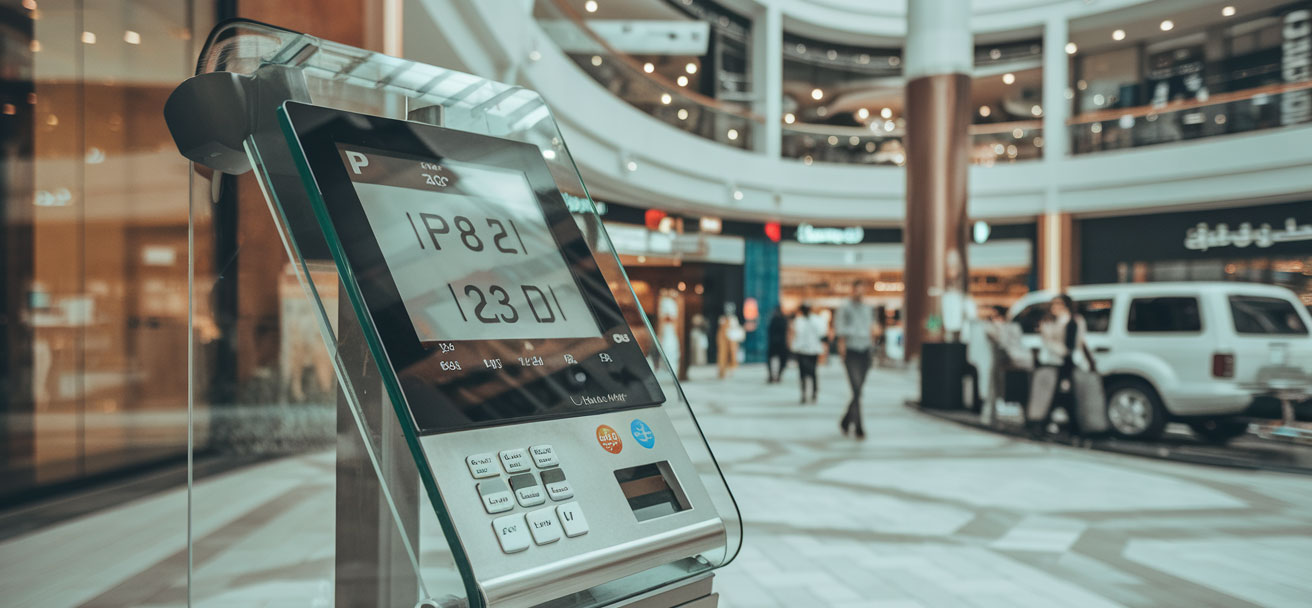Panashi Parking Kiosks – the Essential parking Solution for Middle-east Shopping Malls
Vehicle parking can be a challenging task, especially in crowded cities where vehicle numbers are high and congested spaces are normal. You might have driven your car for a long time in a busy locale to find a parking spot. Yes, it’s quite normal in big cities.
If you are a car parking facility provider, you know the complexities and challenges involved in car parking.
A parking kiosk automates the parking facility operations with utmost efficiency and precision. It streamlines various tasks like entry and exit of vehicles and ticket issuance. And therefore, these kiosk machines are employed in diverse sectors like transportation hubs, shopping malls, hospitals, stadiums, entertainment houses etc.
In this blog, we’ll go through the features and benefits of the same. Read on…


Challenges involved in human-assisted vehicle parking
Human-assisted vehicle parking facilities experiences several challenges on a day-to-day basis. I know most of you have gone through parking the car in an attendant-managed facility. Hence, you can easily relate.
Features of parking Kiosks
Panashi Parking kiosks come in various design formats like the Standalone, or countertop type to suit the unique requirements of the client. We offer plenty of customization options too.
LPR technology for improved efficiency the LPR technology or the License Plate Recognition technology is widely used for vehicle parking management owing to its efficiency and convenience.
The technology facilitates automatic recognition of license plates with cameras and dedicated software applications, and hence eliminating manual intervention and improving operational efficiency. The plate number gets stored in the backend system as a virtual ticket.

Benefits of integrating LPR technology
Here are the most important benefits of integrating the LPR technology into the parking management system.
Parking kiosk operations at shopping malls
The parking kiosk facility at a typical shopping mall involves the installation of self-service parking machines, one at the entrance and the other at the exit of the mall. The exit kiosk, is linked to a barrier to permit/restrict the passage of the vehicle based on parking payment.
Here are the instructions to use a shopping mall parking kiosk. I’ve presented two scenarios, one that insists the use of a ticket for vehicle entry and exit, and the other completely ticketless.
Case 1 – Barcoded Ticket parking
Case 2 – Ticketless parking
LPR technology facilitates automatic, ticketless parking which significantly improves user convenience.
A highly convenient and hassle-free experience! Isn’t it?
Ticketless entry significantly reduces the interaction time at the entry and exit gates, eliminating congestion. Users always prefer a congestion-free parking space as they help them save their precious time!
Parking Kiosks Benefits

Parking kiosks offer several benefits to the facility providers. And the relevant benefits are listed below.
For additional reading on self-service car wash kiosks, please visit our blog here .
Ongoing Trends in the Car parking domain
LPR technology and kiosk integration into parking facilities – I’ve already mentioned parking kiosks, LPR technology and their benefits in the blog. Large parking lots and garages are integrating the parking kiosk and LPR combo into their systems owing to their convenience and efficiency.
Apart from Access Control, LPR technology offers other benefits related to fraud prevention and enforcement.
Fraud prevention - Cars in the parking facility can be linked to their unique license plate numbers and the data gets recorded in the database. This avoids fraudulent attempts to stay for long in the parking facility, or any unauthorised entry.
Avoid Ticket misplacement scenario - The technology can avoid misplacement of tickets or “ticket lost” scenarios, and the resulting unpleasant consequences.
Parking regulations and restrictions – the technology can help parking facility managers to regulate or restrict the entry of vehicles to certain parking areas that are designated for a specific use or purpose. For example, parking lots for the people of determination, employee or VIP parking etc. Additionally, the parking officials may deny access to unauthorised vehicles too.
Sensors for parking assistance – Dedicated sensors can provide real-time space availability information to the drivers. So, the drivers need not drive across the entire facility to find an appropriate parking space.
Even the parking officials can collect the real-time data of vacant spaces and do the required space optimization easily.
There are various types of sensors available like the infrared, ultrasonic, magnetic or radar. These sensors perform space recognition in real-time basis, either from the ground level or few meters above the ground, preferably the ceiling. They also handle continuous tracking of vehicle movements, any changes in the position of cars etc. offering updated, real-time data to the officials.
Cars roaming around in all directions in the facility cause unwanted congestions and negatively impacts the parking experience. Installing parking sensors at appropriate places can help your customers save several precious minutes of their lives!
Parking reservation and payment with mobile apps – Performing parking reservations and payments via mobile apps have gained traction in the recent years. Of course, the convenience is the major factor that attracts the masses towards app-based parking system.
The mobile app companies offer parking facilities in multiple locations, especially in renowned locations. The users can make use of the app to reserve a place for parking, and arrange their travel accordingly. They do not need to visit busy, congested parking facilities or hunt for parking spots. Peace of mind – guaranteed!
Mobile apps like Parkonic offers convenient parking options across various locations in Dubai, Abu Dhabi and Sharjah.
Dynamic pricing strategy for parking lots – the strategy is simple yet highly rewarding. And no wonder, the strategy is implemented by several small and large parking facilities across the globe. The parking fees is regulated based on the parking demand for a particular day, hour, or timeframe. Hence, the parking facility may raise the parking fee in connection with events, peak-hours, holidays etc. If judiciously implemented, the strategy helps the facilities boost their revenue considerably.
RFID technology for parking – By integrating RFID technology into the parking system, the parking facility can offer highly efficient, ticketless parking experience. The technology comprises a RFID tag attached to the body/windshield of the car, and a RFID reader attached to the entry and exit gates.
The RFID reader gathers the vehicle information from the tag every time it enters and exits the gates, enabling automatic lifting of the barrier.
RFID-assisted parking expedites the entry and exit process, prevents fraudulent parking attempts, and enhances the overall security of the parking facility.
The system can also allocate parking bays for vehicles, and the facility becomes handy particularly for large vehicles like trucks.
To add on, the facility providers can easily integrate others systems and applications like loyalty programs into the RFID system.
To conclude
The parking management systems market in the middle-east is a continuously expanding and growing sector fueled by swift developmental activities, infrastructure growth, and rise in vehicle ownership.
In Saudi Arabia, the market is anticipated to achieve notable growth in hospitality, healthcare and transportation sectors. The United Arab Emirates closely follows the trend. The governments in the region see technology as a catalyst for economic diversification.
The self-service parking kiosks offer a highly convenient, safe and hassle-free parking experience for the users. To add on, these kiosk machines streamline the operations and help the facility providers improve their operational efficiency.
If you have large parking garages, you may consider integrating cutting-edge technologies like License Plate recognition (LPR) into the parking management system to streamline the operations and improve the revenue generation process.
Our parking solutions are highly adaptable to various business needs and requirements.
For any assistance or consultation regarding parking kiosk deployment in the middle-east, please get in touch with our technical team of experts.
